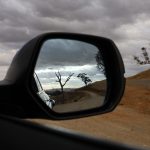I thought I was done with DSLRs and big cameras in general. Like most of you, flagship smartphone cameras have become so good, that it’s increasingly hard to justify taking a dedicated camera to shoot photos. Then Canon reached out and offered a review of their new Canon EOS RP, naturally I was keen to see what had changed in big camera photography lately and it turns out, a lot.
The EOS R series is a new breed of camera. Now mirrorless, there’s no big mechanical thud as you press the trigger, rather a still satisfying click that fires the shutter and sends a 26 megapixel image to a full-frame CMOS sensor. While there’s a lot new to love about the EOS RP, the great news is, you can use your existing investment in glass (read: EF and EF-S lenses via the EF-EOSR mount adapter), however I really appreciated the new third ring of control on the new lenses.
We’re used to seeing canon lenses allow you to adjust zoom and focus and now a third ring allows you to control exposure with an amazing level of control. Often shooting in difficult and changing lighting conditions, this rapid ability to control the exposure easily beats the on-screen controls seen on previous models.
With this camera, Canon are targeting serious photographers that are looking to take their skills to the next level.

DESIGN
Curves in all the right places
To existing Canon owners, the body will be fairly familiar out of the box. The matt black finish offering a stealthy look and the combination of plastics and rubberised surfaces feel great in the hand, giving you great control over the camera. New for me was the change of position for the video recording button, from the back of the camera, to on top. Given your trigger finger is already there to fire the shutter, then this makes lots of sense.
The second change is the control lock which prevents accidental changes to the exposure/iso values using the new third lens ring.
Canon provided 3 lenses to try out the EOS RP. A 35mm macro lens, a 50mm F1.2 prime lens and 24-70mm F2.8 zoom lens. This provided a great opportunity to try the new RF lens system.


PERFORMANCE
How do it perform ?
The specs are fine, but they only tell you so much. Using the camera for the past couple of weeks across a range of environmental conditions, meant I had a great chance to experience the camera (and lens) capabilities. While most times I pulled off the lens cap, it wasn’t time critical, there were times where getting the right shot quickly was important.
Attending Telstra’s 5G launch for Albury Wodonga, I had a small window of time to capture important shots of the 5G device as well as the mayors from both cities posing for photos with the Telstra Regional General Manager. Thankfully having had some time with the camera, along with owning a Canon EOS 650D, I was familiar with the controls enough to capture the photo necessary.
The quality of the photos, depth of field and ability to zoom in to frame shots was unquestionably better than any of today’s smartphones. Sure not everyone attends media events and has this same requirement, but this does highlight, that with the right equipment, you can achieve photos that are much closer to the images you imagined.
Of course if you’re new to this, or you just want to play it safe, you can throw on autofocus. When you have some more time, or you want more control, flicking into manual mode gives you ultimate control. Having people in the foreground and a blurred 5G tower in the background was exactly the shot I was after and the closeup of the 5G speedtest on the phone ticked another must-have shot off the list.
As you’d expect with this quality of glass and image sensor, capaturing photos at night was a complete non-issue and capturing all the complex light that happens when the sun goes down in anything like what the human-eye sees, is the true mark of a great camera. Thankfully the Canon EOS RP excelled, I couldn’t be happier with the photos that it produced, then I checked out videos.
Shooting 4K video is pretty common these days, with the likes of GoPro’s doing it for a couple of generations now. The Canon EOS R can shoot 4K at 24fps. With the right lens and focus, this can look absolutely amazing. You’ll almost certainly need a tripod to keep things steady, but the accuracy at which you can control the focus is not short of stunning.
My biggest take away after using the camera, is that you feel like a professional, in absolute control of the output you create and that can’t be said about capturing the world on with a smartphone. I absolutely appreciated the ability to seemlessly switch between the viewfinder and the 3″ LCD display on the rear.
Sample photos


FEATURES
Stand out features of this camera.
On top of the camera, you’ll find the familiar Canon hotshoe mount. This lets you add an external light, or microphone to the camera, expanding its capabilities even further.
The bottom of the camera offers the familiar battery compartment that can be exchanged for a battery grip to give you even more shooting time. This battery compartment also houses the storage tray for a full-sized SD card. If you use a tripod often, getting the storage media out can be inconvenient, I’d rather this be located on the side.
This takes us to the left side of the camera, which has perhaps the best set of connectivity I’ve seen in a camera for a while. There’s micro-HDMI that’ll give you a clean HDMI output should you choose to use the EOS RP for your next livestream. There’s USB-C, a microphone input, headphone output and a hardware control port.


ISSUES
Not everything’s perfect
One of the big omissions here is a built-in flash. Canon likely made this decision because on more professional shoots, there’s external lighting avialable, certainly in controlled locations.
There’s also no GPS module built-into this camera which means the shots you take won’t have the lat/long co-ordinates in the photo’s metadata.
The 4K video looks amazing, but is limted to 25fps. In a time where 4K60 is pretty much standard, I’d expect next year’s models to include some extra fps.
Finally in the list of issues, I’d like to raise the software. The EOS image transfer tool for the camera is terrible. What I want is to plug in the camera via USB-C, have it show up as a drive and drag off the files. While there’s WiFi avaialble and this weird and clunky image transfer software, I found myself using an SD to USB adapter to transfer files off. With the card located in the bottom of the camera, the tripod mount can get in the way, so agin the USB-C cable should allow for easy file transfer (and charge the camera while they’re going).


PRICE & AVAILABILITY
How much and when can you get one ?
The Canon EOS RP body is worth A$1,869.00 and for what you get, I think that’s great value. This is obviously a price point that will interest semi-serious prosumers up to professionals, but is well under the top of the line DSLR, the EOS 5D Mark IV body which costs A3,399.15 right now.
As for the lenses that I had a chance to review, these don’t come cheap. The RF 50mm f/1.2 lens costs more than the body at A$3,299.00. The RF 24-70mm F2.8L IS USM costs a mouth-watering A$4,499.00 and the RF 35mm f/1.7 Macro IS STM lens costs a more modest A$749.00.
The Canon EOS RP and lenses are avaialble from Canon directly, or from any of a large number of Canon resellers.


OVERALL
Final thoughts
There’s been a few products that have surprised me this year, but none as much as the Canon EOS RP. This camera made me rethink my position on big cameras and in a world where mobiles are dominating, cameras like this make me enjoy photography again. Thanks to a lightweight body, weighing just 485 grams, it really is just the lens that you bolt on that adds significant weight.
The mirrorless, full-frame sensor, combined with some amazing lenses, enable this camera to take some absolutely stunning photos. I was surprised how often I used the new lens ring to control the exposure of the photos, that’s actually a real asset. While phone cameras typically have a ‘Pro’ mode, nothing comes close to the feeling of control you have in a camera like this. Ultimately that control makes the life of a photographer better, allowing you to have much more confidence that you’ll be able to control the resulting photo.
For everything I reviewed, the setup costs around $10k which is a big number, but what a fantastic combination of camera and lenses. The great thing about modular camera systems is that you really can pick and choose based on the type of photography you’re keen on. If you’re able to turn your photography from a hobby into a career, funding your next lens shouldn’t be a problem.
What Canon have produced here with the EOS RP is a brilliant upgrade on the original EOS R model, its smaller, lighter, but more capable. While the camera lacks GPS and the ability to shoot 4K at 60fps, those are honestly such small criticisms, overall this is a great bit of kit if you can find the budget.



















